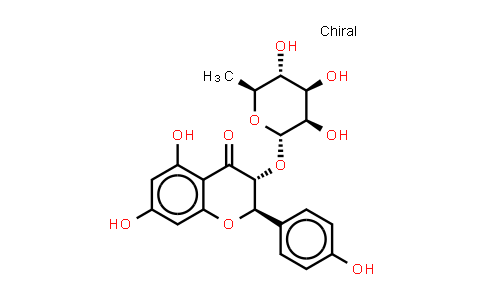
Astilbin NLT 98%
SKU : MC547050
CAS Number : 29838-67-3
Molecular Formula : C21H22O10 | Molecular Weight : 434.39
Quote Request| Purity | NLT 98% |
|---|---|
| Storage | at 20ºC 2 years |
* The above information is for reference only.
* If the product has intellectual property rights, a license granted is must or contact us.
| Chemical Name | Astilbin |
|---|---|
| CAS Number | 29838-67-3 |
| MDL Number | MFCD01632717 |
| Molecular Formula | C21H22O10 |
| Molecular Weight | 434.39 |
Astilbin, a flavonoid compound, is isolated from the rhizome of Smilax glabra. Astilbin enhances NRF2 activation. Astilbin also suppresses TNF-α expression and NF-κB activation. IC50 & Target: NRF2,TNF-α,NF-κB[1] In Vitro: Astilbin is a common dietary flavonoid that can be found in various kinds of herbs and foods such as Smilax Glabra, Sarcandra glabra, grape and red wine. Astilbin markedly inhibits cisplatin-induced cell apoptosis and recovers cell growth. Astilbin significantly decreases reactive oxygen species (ROS) accumulation and alleviates ROS-induced activation of p53, MAPKs and AKT signaling cascades, which in turn attenuates cisplatin-induced HEK-293 cell apoptosis. Astilbin effectively enhances NRF2 activation and transcription of its targeting antioxidant genes to reduce ROS accumulation in cisplatin-induced HEK-293 cells. Astilbin obviously suppresses tumor necrosis factor alpha (TNF-α) expression and NF-κB activation, and also inhibits the expression of induced nitric oxide synthase (iNOS) and cyclooxygenase-2 (COX-2). To measure the effects of Astilbin on the growth of CDDP-treated renal cells, HEK-293 cells are treated with CDDP (100 μM) and/or Astilbin (200 μM). Astilbin treatment significantly improvescell growth in CDDP-induced HEK-293 cells[1]. In Vivo: To explore whether Astilbin improves CDDP-induced nephrotoxicity in vivo, an acute cisplatin nephrotoxic mouse model is established. Single injection of CDDP with 8 mg/kg dose results in notable weight loss compared with control group. However, the phenomenon is significantly alleviated by Astilbin at dose of 50 mg/kg. The mice fed Astilbin alone do not show any obvious alteration in body weight. Similarly, serum creatinine (SCr) and blood urea nitrogen (BUN) are higher in CDDP-treated mice than in control group. Treatment with Astilbin also decreases SCr and BUN levels. To examine the protective effect of Astilbin on CDDP-induced renal histopathological damage, the mouse kidney sections are stained with H&E. The mice in control group and Astilbin treated group have normal kidney morphology, while kidneys in CDDP group show severe damage with tubular degeneration, necrosis and cystic dilatation of the tubules with focal hemorrhages. Administration of Astilbin mitigated kidney injury, resulting in lower histopathological score compared to CDDP group. The apoptosis of renal cells is also detected using TUNEL staining to determine whether Astilbin treatment decreased renal cell apoptosis in CDDP-induced acute nephrotoxic mice[1].
Related Products
© Copyright 2015-2024 Hangzhou MolCore BioPharmatech Co.,Ltd. All rights reserved.
